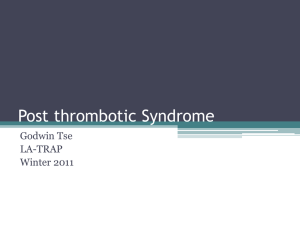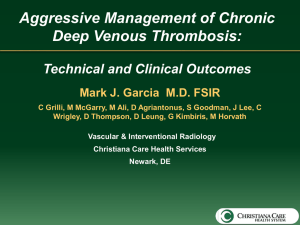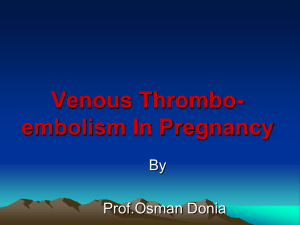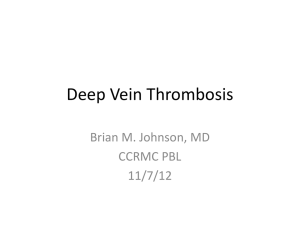32.acute venous insufficiency.
advertisement
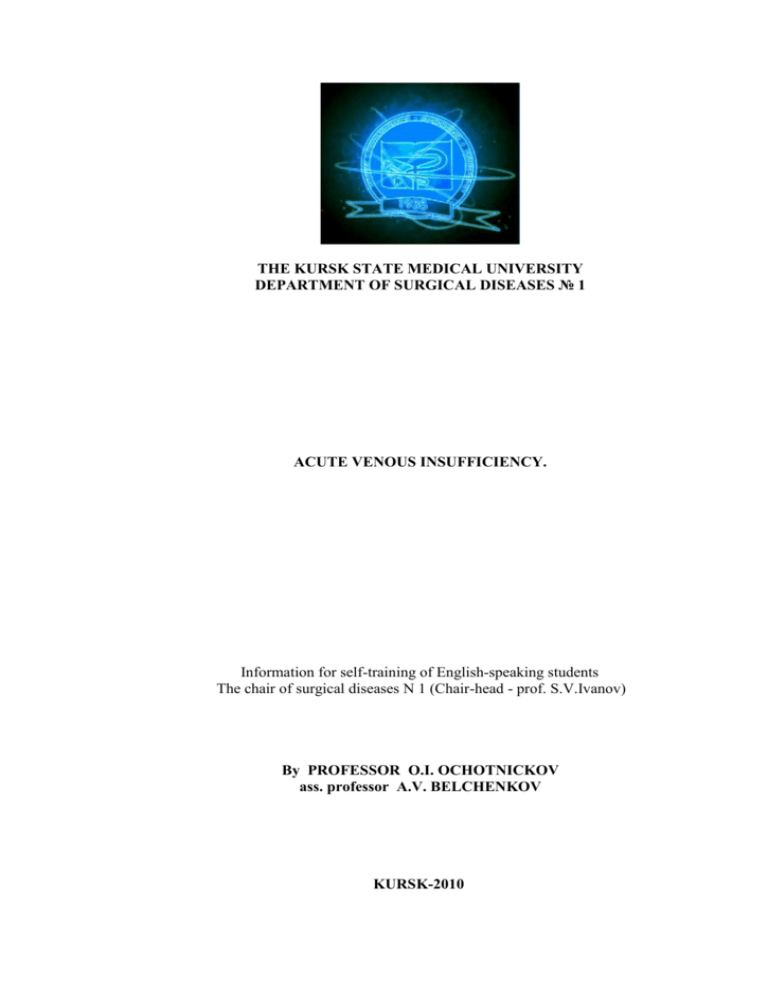
THE KURSK STATE MEDICAL UNIVERSITY DEPARTMENT OF SURGICAL DISEASES № 1 ACUTE VENOUS INSUFFICIENCY. Information for self-training of English-speaking students The chair of surgical diseases N 1 (Chair-head - prof. S.V.Ivanov) By PROFESSOR O.I. OCHOTNICKOV ass. professor A.V. BELCHENKOV KURSK-2010 INTRODUCTION The annual incidence of DVT is 5 per 10,000 in the general population. The 5-year cumulative incidence of recurrent DVT is approximately 20%. Prevalence of DVT is 0.5% at age 50 years and 4.5% at age 75 years. The risk of DVT increases two fold during each 10-yearincrease in age. Without prophylaxis, the incidence of postoperative DVT is 40–80% in patients undergoing large orthopaedic surgery.The corresponding numbers in general surgery are 20–40%. In vascular surgery, several Duplex or venography-based studies have shown that the rate of DVT is 18–32% after abdominal or lower limb reconstructions. Postoperative DVT has been noted in 12% of the legs after abdominal vascular surgery despite medical prophylaxis. Superficial thrombophlebitis may be associated with DVT. In legs with large-scale thrombophlebitis involving the saphenofemoral or saphenopopliteal junction, DVT may be present in as much as 40% of cases. AETIOLOGY The following three factors, primarily postulated by Virchow, are most important in the pathophysiology of deep venous thrombosis: 1. Injury of vessel wall 2. Abnormalities of blood (coagulation disorders) 3. Abnormalities of blood flow (stasis). There are multiple risk factors for DVT, but the independence and magnitude of each are unclear: 1. Increasing age 2. Cancer 3. oagulation disorder 4. Smoking 5. Obesity 6. estrogen substitution 7. Surgery (hip or knee arthroplasty, cancer surgery in the abdominopelvic area, neurosurgery) 8. Trauma 9. Immobilization (air-related DVT) 10. Previous DVT. SYMPTOMS AND SIGNS Typical symptoms are calf pain (pain at rest and also during walking), and oedema of the calf or the wholeleg. Acute DVT may be asymptomatic, especially in postoperative patients, or the first sign may be pulmonary embolism..3 Diagnosis Typical signs are pain in calf palpation and pitting oedema. Cyanotic or pale colour may be seen in massive DVT occluding all collateral veins and finally arteries (phlegmasia cerulea dolens, phlegmasia cerulea alba). Anamnestic risk factors should be mapped: existing cancer, significant immobilization (extremity paresis, use of a cast, bedrest), recent (< 1 month) surgery or trauma, existing coagulation disorder. INVESTIGATION LABORATORY TESTS Degradation of fibrin can bemeasured by D-dimer. Fibrin levels are elevated in acute DVT, but some other conditions may elevate these levels too (e.g. cancer, inflammation, postoperative period). C-reactive protein may be elevated in acute DVT. Coagulation disorders should be screened in selected cases: idiopathic DVT, a family history of DVT or pulmonary embolism, and recurrent DVT. Congenital and acquired disorders have to be evaluated: factor V Leiden, prothrombin, antithrombin deficiency, protein S and protein C deficiency, hyperhomocysteinaemia (congenital), antiphospholipid antibodies (acquired). Genetic studies can be performed during anticoagulation, but most other measurements need to be done later. US Duplex scanning is a practical method of assessing blood flow in veins and valve cusp movements. It can differentiate between acute and chronic thrombosis. All the major deep veins of the lower limb can be assessed. The technique is less accurate for the small veins of the calf and cannot demonstrate the presence of thrombi in these small veins. However, in many cases this depends on the ability and the experience of the technician. The vein is scanned in transverse and sagittal planes. The presence of thrombosis is evaluated by the compressibility of the vein. In addition, a vein without thrombus should show Doppler evidence of flow, variation with respiration and increase when distal veins are compressed. Recent thrombi tend to be anechoic and only later will show characteristic internal echoes. There are 2 types of the thrombosis: 1- occlusive, 2 – non occlusive. The non occlusive thrombosis divided on 2 – flotting and parietal. Duplex scanning of the superficial and deep veins is the preferred imaging technique to asses venous disorders of the legs. VOLUME PLETHYSMOGRAPHY Pulse volume recorders are used to assess venous outflow. Two components of the curves are used: first, the circumference changes after the inflation of the cuff; second, the downslope of the curve after immediate deflation. In the case of thrombosis, the downslope will be slow. For calculation, two values are used: the maximum increase in calf volume and the maximum venous outflow during the first second after deflation of the cuff. Both of these values are decreased in patients with DVT. DIFFERENTIAL DIAGNOSIS Differential diagnosis of DVT includes: 1. Ruptured Baker’s cyst 2. Superficial thrombophlebitis (слайд) 3. Acute arterial ischaemia 4. Cellulitis (слайд) 5. Haemorrhage inside the limb 6. Acute arthritis 7. Torn calf muscles 8. Pelvic or intra-abdominal tumours obstructing theveins. European Standard 1. Symptom-based diagnosis of acute DVT is insufficient. 2. Normal D-dimer is accurate at excluding DVT in patients with a low or moderate clinical probability of DVT. No further studies (including ultrasound) are needed. 3. Duplex ultrasound imaging should be used together with D-dimer in patients with a high clinical probability of DVT. 4. Venography should be used in cases where the Duplex ultrasound imaging results are unclear. TREATMENT Conservative Treatment of DVT The Use of Anticoagulants Low-molecularweight heparin (LMWH) can be used as a primary treatment of acute DVT. LMWHs are as efficient as intravenous unfractionated heparin, but they have several advantages (e.g. no need to observe coagulation parameters, subcutaneous injections and safety). Medical treatment should be started as quickly as possible, because this may reduce the rate of recurrence Warfarin given simultaneously with LMWH, but the doses need to be adjusted carefully in each case (3–10 mg per day), especially in elderly patients. The international normalized ratio (INR) should be adjusted to between 2.0 and 3.0 for 2 days before LMWH treatment is stopped. Outpatient treatment of acute DVT is an acceptable alternative in co-operative patients. The duration of anticoagulation should bemore than 3 months in patients with idiopathic DVT. A 3-month treatment may be adequate in patients with nonidiopathic DVT. Permanent anticoagulation can be considered in recurrent cases with sustained aetiological factors such as cancer or coagulation disorder. Compression therapy may reduce the incidence of post-thrombotic syndrome up to 50% in patients with DVT at the popliteal level or more proximally. A kneelength stocking is sufficient, and its efficacy is based on enhancement of calf musclepump function Early ambulation with adequate compression treatment in proximal DVTs may reduce leg symptoms, and there is no increased risk of pulmonary embolism. Compression therapy needs to be continued for up to 2 years, because postthrombotic syndrome typically occurs within the first 2 years after acute DVT. The main problems during anticoagulant treatment with warfarin are bleeding and not optimal INR levels. The prevalence of bleeding is approximately 2%, and the risk increases markedly when the INR level is higher than 3.0. A low INR level may raise the risk of recurrence, and even have an influence on the resolution of the thrombus. European Standard 1. Subcutaneously administered LMWHs are first-line treatment of acute DVT. 2. Treatment with LMWHs should be started as quickly as possible. 3. Length of warfarin treatment needs to be more than 3 months in idiopathic cases, and the INR should be maintained between 2.0 and 3.0. 4. Compression treatment with below-knee stocking (30–40 mmHg pressure at the ankle) is indicated in the treatment of acute DVT. 5. Duration of compression treatment is 2 years. 6. The coagulation system has to be screened in selected patients. INVASIVE TREATMENT OF DVT Indications for Invasive Treatment 1. Preservation of valvular function has been the main reason for treating acute DVT invasively. 2. There is only moderate evidence as to how this preservation can be achieved. 3. Acute massive (supra-inguinal DVT) thrombosis may indicate invasive treatment in selected cases. 4. The symptomatic period should be less than 1 week. However, it is difficult to determine the duration of DVT. 5. Patient’s life-expectancy should be long, because the main goal is to maintain the long-term function of venous valves. Therefore, having cancer and being old (>70 years) are relatively contraindications to these treatments. 6. Invasive treatment should be considered in complicated DVT such as phlegmasia cerulea dolens, phlegmasia cerulea alba and venous gangrene. However, no randomized studies comparing conservative and invasive treatment or comparing different invasive treatments are available. 7. Data on treatment of complicated DVT are mainly based on case reports and uncontrolled series. Thrombolysis Thrombolysis can be done systemically or locally (catheter-directed) into the thrombus by using tissue plasminogen activator or urokinase or streptokinase. Catheter-directed lysis seems to have a better outcome compared to anticoagulant treatment or systemic lysis. In catheter-directed lysis, the catheter is placed intravenously inside the thrombus and slow infusion is given. Treatment is followed by repeated venograms, and the duration of treatment is typically 24–48h. It is very important to detect underlying stenotic segments, typically in the left common iliac vein, and to treat them with balloon angioplasty and, if necessary, with stenting. Anticoagulation with LMWHs should be started before invasive treatment. The incidence of pulmonary embolism in catheter-directed lysis is low, 0–1%. Thrombectomy Thrombectomy, too, can be used in the removal of acute thrombus. However, its protective power to prevent post-thrombotic sequelae is also unclear. Surgical thrombectomy should be done under general anaesthesia, and positive end expiratory pressure (20 mmHg) needs to be used to prevent pulmonary embolism. Thrombectomy of a proximal thrombus can be achieved with a Fogarthy catheter. Distally the thrombus can be removed mechanically with compression bandages or by hand compression. Reconstruction of arteriovenous fistula can be combined with the procedure. Surgical thrombectomy should always be combined with peri- or an immediate post-operative venogram to image the proximal (iliac) veins. If stenosis is detected, balloon angioplasty and stenting should be considered. These methods combine the use of local lytic therapy and mechanical removal of the thrombus. European Standard 1. Catheter-directed thrombolysis can be considered in massive (supra-inguinal) acute DVTs with relatively young and healthy patients. 2. Patients with poor outcome (cancer, old age) should be treated with anticoagulants. 3. Long-term symptoms (i.e. more than 1 week) should contraindicate invasive treatment. 4. Regardless of the method of invasive treatment, such as catheter-directed lysis, surgical thrombectomy and endovascular mechanical thrombectomy, the proximal outflow tract has to be imaged in all cases to reveal and treat the underlying pathology. 5. Treatment with LMWHs should be started before invasive treatment. POSTOPERATIVE DVT Without prophylaxis the incidence of DVT is very high after hip or knee arthroplasty, hip fracture surgery and abdominopelvic cancer surgery. The risk of postoperative thromboembolism is sustained for at least 1 month after surgery. In general, postoperative patients can be divided into three categories according to consensus statement: low risk, moderate risk and high risk. Medical prophylaxis is performed by using LMWHs, which can be started either preoperatively (12 h before the operation) or postoperatively (6–12 h after the operation). Fondaparinux is a selective factor Xa inhibitor, and can be used for prophylaxis after knee or hip surgery (elective arthroplasty or hip fracture surgery). Fondaparinux is started 6 h postoperatively. There are strong data available on the superiority of fondaparinux over enoxaparin in preventing DVT in orthopaedic surgery. Ximelagatran is a direct thrombin inhibitor, which is more effective than dalteparin for prophylaxis of postoperative DVT. Ximelagatran can be given orally, whereas LMWHs and fondaparinux are administered subcutaneously. Knee-length compression stockings and early ambulation after surgery should be used to prevent DVT, together with medical prophylaxis. The duration of prophylaxis should be 5–7 days in patients without high risk. Prolonged prophylaxis is indicated in hip or knee arthroplasty, abdominopelvic cancer surgery and in patients with coagulation disorder. In these cases, treatment with LMWHs or fondaparinux is continued up to 4 weeks. nosis PROGNOSIS Acute thrombosis may destroy venous valves in affected segments. The rate of recanalization is high after acute DVT, but valvular reflux may remain. Recanalization typically occurs during the first year after DVT. It may be delayed or fail at iliac veins. The 5-year incidence of post-thrombotic syndrome is about 30% in patients treated with anticoagulants. Prognosis after acute DVT is difficult to determine; even calf DVT may lead to late sequelae. Subsequent events after the acute phase, such propagation and rethrombosis, may have an impact on prognosis

